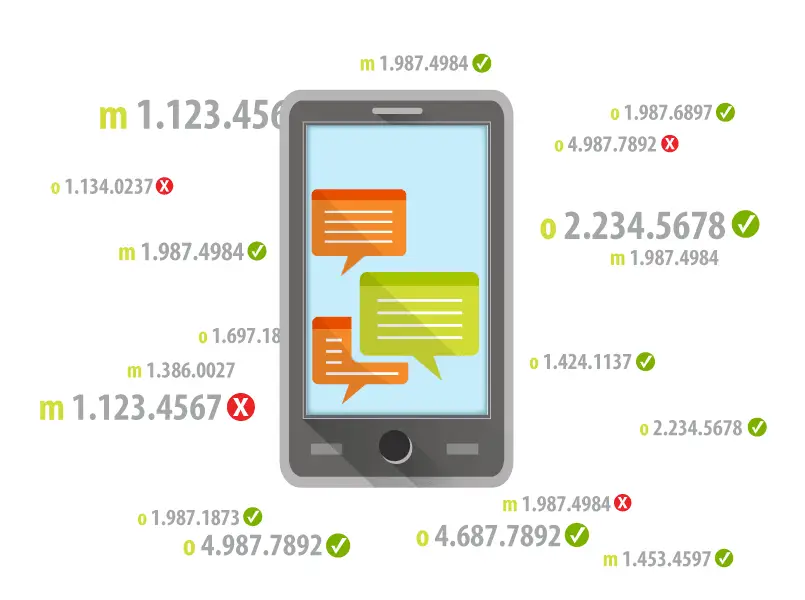Update: If you want to know our API to validate a phone number visit the section:
“Service to validate phone numbers worldwide”.
Validating a phone number is a necessary process in order to work with a quality database. In this article you will learn why phone number validation is important, the different methods of verification and what marketing campaigns can be carried out on these numbers.
Why validate a phone number
Having a validated number allows us to have the certainty of being able to contact our users through calls, SMS or WhatsApp messages. If we do not validate the telephone numbers, we will not know reliably which numbers are valid and which are not.
If we use the SMS channel as a communication mechanism, we will be consuming sending credits unnecessarily. Taking into account that the cost of an SMS is 0.036€/SMS in Spain. The cost of sending to invalid numbers is not negligible.
It is estimated that each year, 5% of the numbers captured are no longer valid. Although this figure is considerably lower than the obsolescence of email, its impact is not negligible because of its higher price.
If we can identify the telephone numbers that are no longer valid, prior to sending a campaign. We will be able to use other channels to be able to pick up the phones again.
At an economic level, validating 1,000 phones costs 5€. If we had sent the campaign directly instead, the cost of the campaign would be 36€ for SMS campaigns in Spain.
Methods to validate a telephone number
We have developed 2 methods for phone number verification. To validate a telephone number we can use the API in real time or the verification in batch mode using an Excel file.
Verification by Excel file
The verification process is very simple. We only have to copy the telephone column that we want to validate in our Excel sheet and press the check button.
This action will trigger a process that will check each number and return information about its validity, country and number operator.
Phone validation also returns the type of line (landline or mobile), the country, the international code and the operator of the line.
The level of reliability is very high, reaching over 99% reliability. The verification performs a set of number checks and checks the global database for the veracity of the data.
The only data with less reliability is the operator, since in the worst case it is renewed on a bi-monthly basis.
API validation
The API is a mechanism that allows us to program the number verification process. The API is Rest, during the call we only have to send the token with which we want to perform the verification and pass as parameter the number we want to verify. Define whether to pass a country code and the format of the number.
http://telefono.verificaremails.com/api/validate?access_key=”apikey”&number=” number”&country_code=EN&format=1″
As a result, we return a JSON with the verification results:
{
“valid”:true,
“number”:”34934511100″,
“local_format”:”934511100″,
“international_format”:”+34934511100″,
“country_prefix”:”+34″,
“country_code”: “EN”,
“country_name”: “Spain”,
“location”: “Barcelona”,
“carrier:””,
“line_type”: “landline”.
}
If we are only interested in knowing if the phone is valid we must use the “valid” field. This field can return 2 values, true or false.
Once we have validated the phone number, we can safely use it in our SMS, voice or WhatsApp campaigns.
We will soon be launching the phone validation service with the same interface as the mail verification. The user can upload their files with phone numbers and the service will perform the verification.
Voice marketing campaigns
The vast majority of companies use validated phone numbers for SMS campaigns. The advantage of these campaigns is that they are economical and allow you to communicate efficiently with users.
The main limitation is that the messages we can send are restricted to 160 characters and are one-way messages.
WhatsApp breaks this limitation, but introduces a greater one and that is that we can only use this channel in very specific use cases such as logistics or support applications and the use in the communication environment is prohibited.
For this reason we have developed a third way. The use of the voice channel to communicate with users in a bidirectional manner. Through and voice commands or using the keypad
If you are interested in this topic, I recommend you to download our PSF presentation “Automatic voice campaigns” to see all the possibilities.
Real-time phone number verification
A variant of using the API is real-time phone verification using the API and registration forms.
The user fills out a form and sends his data to the server. We can then verify the veracity of the telephone number entered. If the user has made a mistake or intentionally entered an invalid number, we can detect it and instruct the user to correct it.
This type of validation is performed once the data has been sent. We have a library where the verification takes place in “background”, that is, while the user completes the phone field and moves to the next field of the form. We verify the data. Before the user submits the form we are able to detect the veracity of the number.
If the number is correct we do nothing, but if it is invalid we show an error message telling you to correct it. At the implementation level, the deployment of this library is simple and greatly improves usability and user experience. Its operation is very similar to that of the email verification library.
Other applications
We have recently discovered an interesting use of the phone number verification service. By validating the numbers we can reliably know the telecom operator supporting the line.
The companies that market telephone services are using our service to know which operator corresponds to each number and avoid calling customers who are already users. 37% of the calls of those marketed are made to customers.
Another application of the number validation service is related to identity verification. Many users enter an invalid email address or phone number when registering for a service. An email verification or phone number validation service can help detect users who attempt to spoof their identity.
This is very useful to avoid creating a database with incorrect data but also to filter and direct the work of our sales force. If you are doing things right, you should generate more leads than potential customers. Directing commercial efforts to those real users and forgetting those users who only introduce noise in our acquisition funnel is a first step towards an efficient sales funnel.
Conclusions when validating a telephone number
In this article we have seen how to validate a phone number via API or through an Excel file. The verification mechanism is simple and easy to deploy in minutes. The advantage of verifying our numbers ranges from improving the quality of the database to reducing costs in our SMS or voice marketing campaigns.
If you need help to validate your phone numbers, emails, or data quality… Contact us and we will offer you a customized solution that fits your needs.



